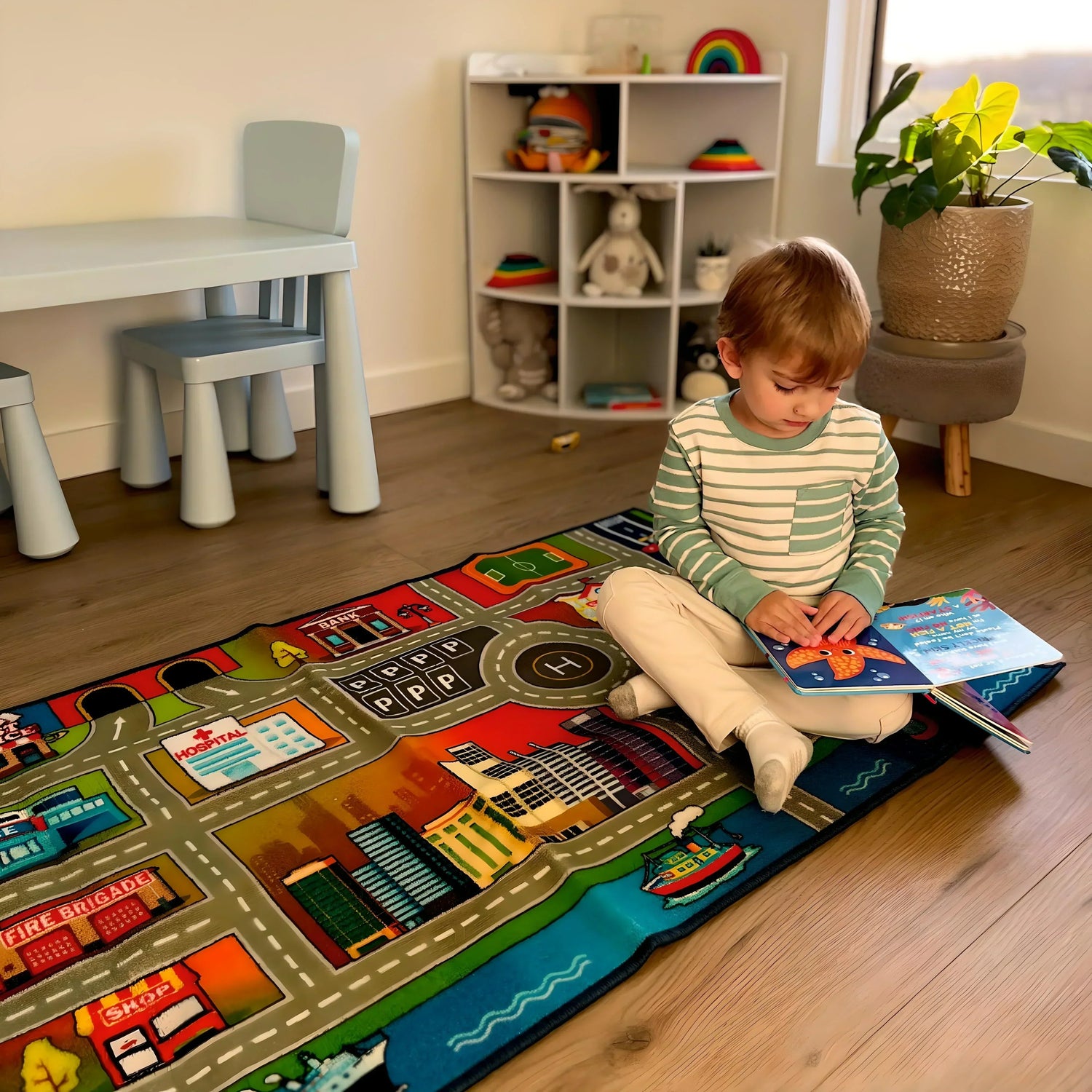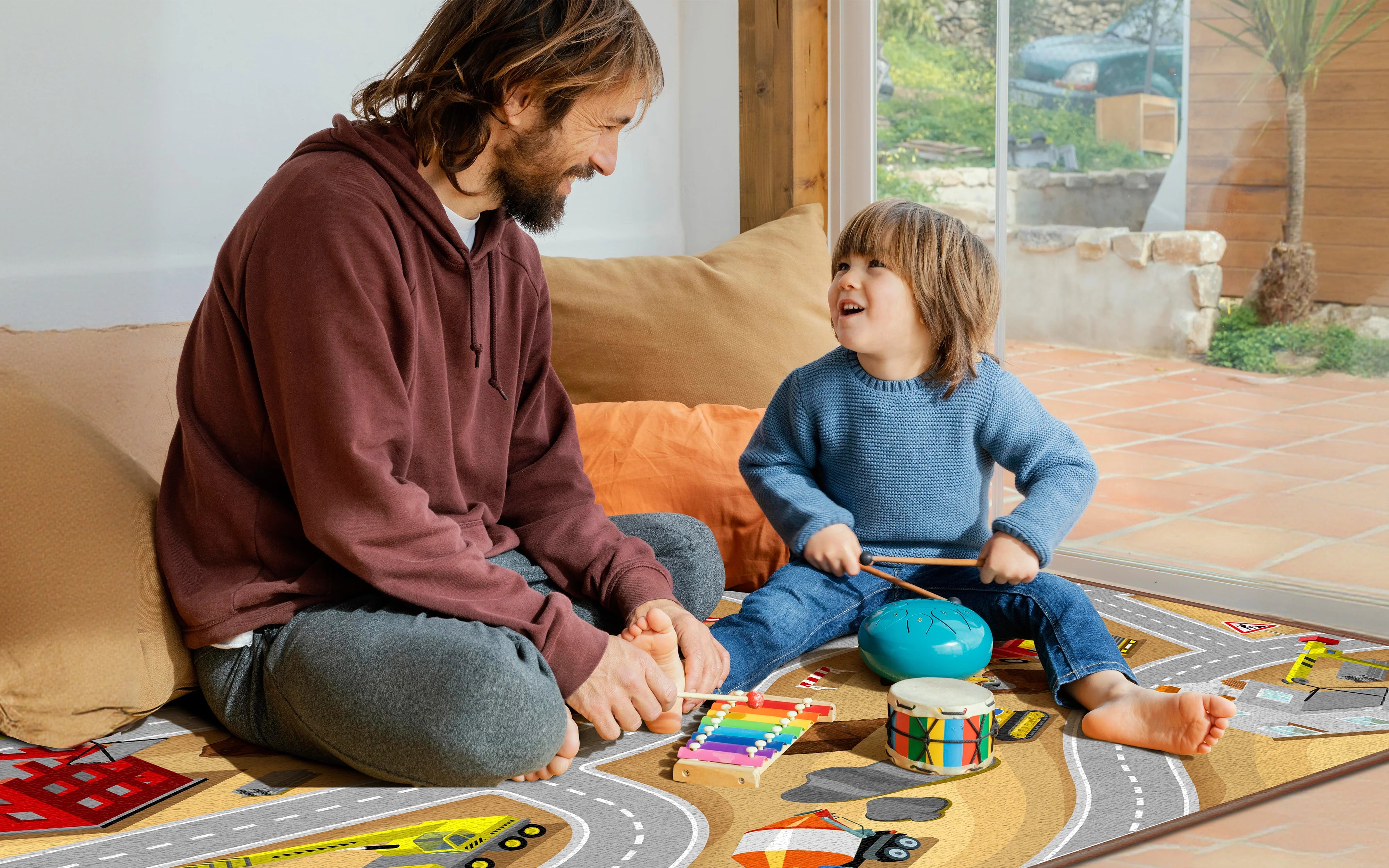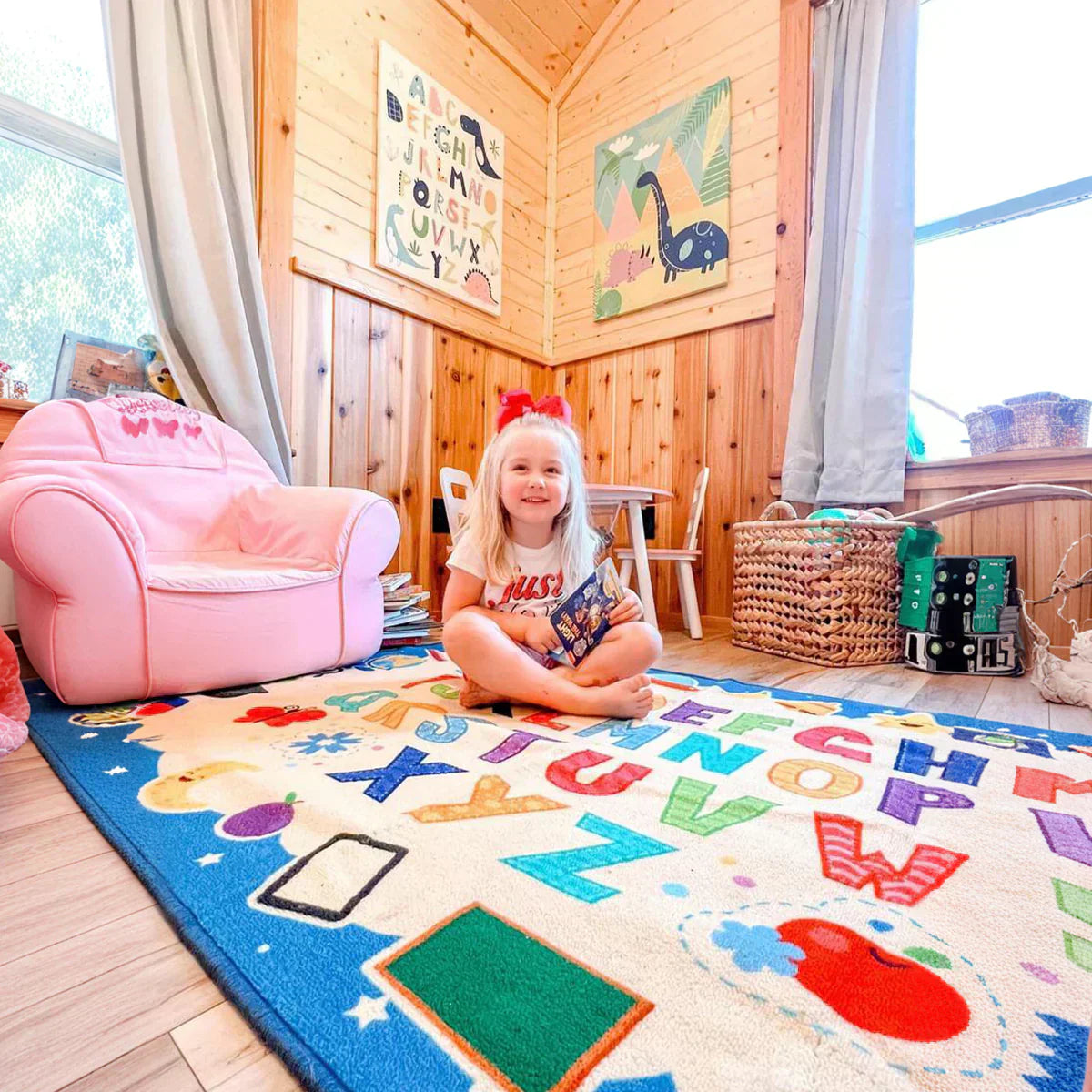Why Classroom Rugs Are Essential Educational Tools
Research from pediatric occupational therapy demonstrates that children engage in 37% longer periods of sustained attention when positioned on appropriately cushioned surfaces versus hard flooring. Beyond comfort, quality educational rugs provide crucial benefits that directly impact student success.
Learning Enhancement Benefits:
- Improved Focus: Soft surfaces help children maintain comfortable "ready to learn" positions during instruction
- Better Acoustics: Strategic placement of dense classroom rugs can improve signal-to-noise ratio by 7-10 decibels without expensive acoustic panel installations
- Sensory Support: Varied textures support sensory integration, particularly beneficial for children with special needs
- Visual Learning: Educational patterns transform passive floor space into interactive teaching tools
Classroom Management Advantages:
- Personal Space Definition: Individual seating spots eliminate disputes during circle time
- Transition Efficiency: Visual cues reduce transition times between activities by an average of 4.5 minutes per transition—potentially reclaiming over 30 instructional minutes daily
- Natural Grouping: Color-coded sections facilitate instant group formations
- Behavioral Support: Environmental design reduces teacher directive statements by approximately 40%
Essential Safety Standards for Educational Rugs
When selecting classroom rugs, safety must be the top priority. All educational floor coverings should meet stringent safety requirements to protect young learners.
Critical Safety Features:
- Fire Rating: Class 1 fire-rated materials for commercial educational use
- Non-Toxic Materials: Free from PVC, phthalates, and lead
- Slip Resistance: Professional-grade backing to prevent accidents
- Hypoallergenic Properties: Resistant to dust mites, mold, and mildew
- ASTM & CPSC Compliance: Rigorous testing to meet international safety standards
At Booooom Jackson, we understand that safety isn't negotiable. That's why all our educational rugs undergo comprehensive testing to ensure they meet or exceed safety requirements for classroom use.
Why Classroom Rugs Are Essential Educational Tools
Research from pediatric occupational therapy demonstrates that children engage in 37% longer periods of sustained attention when positioned on appropriately cushioned surfaces versus hard flooring. Beyond comfort, quality educational rugs provide crucial benefits that directly impact student success.
Learning Enhancement Benefits:
- Improved Focus: Soft surfaces help children maintain comfortable "ready to learn" positions during instruction
- Better Acoustics: Strategic placement of dense classroom rugs can improve signal-to-noise ratio by 7-10 decibels without expensive acoustic panel installations
- Sensory Support: Varied textures support sensory integration, particularly beneficial for children with special needs
- Visual Learning: Educational patterns transform passive floor space into interactive teaching tools
Classroom Management Advantages:
- Personal Space Definition: Individual seating spots eliminate disputes during circle time
- Transition Efficiency: Visual cues reduce transition times between activities by an average of 4.5 minutes per transition—potentially reclaiming over 30 instructional minutes daily
- Natural Grouping: Color-coded sections facilitate instant group formations
- Behavioral Support: Environmental design reduces teacher directive statements by approximately 40%
Essential Safety Standards for Educational Rugs
When selecting classroom rugs, safety must be the top priority. All educational floor coverings should meet stringent safety requirements to protect young learners.
Critical Safety Features:
- Fire Rating: Class 1 fire-rated materials for commercial educational use
- Non-Toxic Materials: Free from PVC, phthalates, and lead
- Slip Resistance: Professional-grade backing to prevent accidents
- Hypoallergenic Properties: Resistant to dust mites, mold, and mildew
- ASTM & CPSC Compliance: Rigorous testing to meet international safety standards
At Booooom Jackson, we understand that safety isn't negotiable. That's why all our educational rugs undergo comprehensive testing to ensure they meet or exceed safety requirements for classroom use.
How to Choose the Perfect Classroom Rug Size
Selecting the right dimensions for your classroom rug requires careful consideration of your space, student count, and intended activities. Ideally, rugs should provide roughly 24 inches of space per student.
Size Guidelines by Class Size:
- 6'9" x 9'5" - Accommodates up to 18 small children
- 7'6" x 12' - Seats up to 26 students comfortably
- 8'3" x 11'8" - Perfect for 30 students
- 8'4" x 13'4" - Accommodates up to 35 children
Activity-Based Sizing:
- Morning Meetings & Read-Alouds: Larger rectangular rugs (8x10 or 9x12)
- Small Group Work: Medium squares (6x6 or 6x8)
- Individual Stations: Smaller accent rugs (4x6)
- Circle Time: Round or oval rugs for equitable participation
Pro Tip from Educators: Before purchasing, use newspaper or tape to create a full-size template on your classroom floor. Have students sit within the outlined area to ensure comfortable spacing and proper circulation paths.
2025 Classroom Rug Trends: What's Hot in Educational Design
The classroom rug industry is evolving rapidly, with 2025 bringing exciting new trends that combine functionality with contemporary aesthetics.
Top Design Trends for 2025:
1. Natural Fiber Revival Search interest for Natural Fiber Rugs surged to a normalized value of 60 in January 2025, outpacing other queries by 67%. Eco-conscious educators are choosing sustainable materials like jute, wool, and recycled fibers.
2. Washable Functionality Washable functionality drives demand, with Vintage Floral Washable sales up 70% since November 2024. Modern families and educators prioritize easy-care options that maintain their beauty through daily use.
3. Earthy Color Palettes Warm shades like sienna, umber, and terracotta are going to be popular in carpet trends in 2025. These calming tones create serene learning environments while remaining versatile for various décor themes.
4. Texture-Forward Designs Chunkier, shaggier, and more dimensional rugs are trending, offering handcrafted appeal and adding critical warmth and character to minimalist spaces. Tactile elements support sensory learning while adding visual interest.
5. Irregular Shapes Breaking away from traditional rectangles, irregular shapes are a refreshing way to think about floor covering, bringing it to the foreground, rather than making it a background character.
Educational Benefits: Curriculum-Integrated Rug Designs
Modern classroom rugs do double duty as teaching tools, incorporating educational elements directly into their design patterns.
Subject-Specific Learning Rugs:
Mathematics Integration:
- Coordinate grids for spatial reasoning development
- Number lines for counting and sequencing activities
- Geometric shapes for hands-on geometry lessons
- Hundreds charts for place value understanding
Language Arts Enhancement:
- Alphabet patterns supporting phonics instruction
- High-frequency word exposure through repetitive design
- Reading nooks with book-themed illustrations
- Phonics learning stations clearly defined by rug boundaries
Geography & Social Studies:
- World maps for cultural awareness activities
- USA maps for state identification games
- Compass roses for directional learning
- Community helpers themes for social understanding
Science Exploration:
- Solar system designs for astronomy lessons
- Animal habitats for life science units
- Weather pattern illustrations
- Plant life cycles for biology basics
Material Matters: Choosing Durable, Child-Safe Fabrics
The construction and materials of your classroom rug directly impact its longevity, safety, and educational effectiveness.
Premium Material Options:
100% Nylon Construction:
- Superior durability for high-traffic areas
- Fade-resistant colors that maintain vibrancy
- Easy-clean properties for busy classrooms
- Professional-grade stain resistance
Natural Fiber Alternatives:
- Jute: Sustainable, textured, and naturally antimicrobial
- Wool: Naturally flame-resistant and incredibly durable
- Cotton: Soft, breathable, and often machine-washable
- Bamboo: Eco-friendly with natural antibacterial properties
Backing and Edge Considerations:
- Gel-back systems for slip resistance
- Bound edges to prevent fraying
- Antimicrobial treatments for hygiene
- Low-pile construction for easy maintenance
Our premium classroom rugs feature advanced construction techniques that ensure your investment lasts for years while maintaining its educational and aesthetic value.
Age-Appropriate Selections: From Preschool to Elementary
Different age groups have distinct developmental needs that should influence your rug selection strategy.
Preschool & Kindergarten (Ages 3-5):
- Size Focus: Individual seating spots 18-20 inches per child
- Design Elements: Large, simple patterns with basic concepts
- Colors: Bright, primary colors for visual stimulation
- Features: Extra cushioning for floor time comfort
- Themes: Letters, numbers, shapes, animals
Early Elementary (Ages 6-8):
- Size Focus: 22-24 inches per student for growing bodies
- Design Elements: More complex educational content
- Colors: Balanced palettes supporting concentration
- Features: Defined zones for different activities
- Themes: Maps, multiplication tables, reading corners
Upper Elementary (Ages 9-11):
- Size Focus: Standard adult spacing of 24+ inches
- Design Elements: Sophisticated patterns and concepts
- Colors: Calming, mature color schemes
- Features: Multi-functional spaces for varied learning
- Themes: Science concepts, historical timelines, literature themes
Maintenance and Care: Keeping Your Investment Beautiful
Proper maintenance extends the life of your classroom rug while ensuring a healthy learning environment for students.
Daily Maintenance Routine:
- Regular Vacuuming: Remove daily debris and prevent embedded dirt
- Spot Cleaning: Address spills immediately with approved cleaners
- Traffic Pattern Rotation: Prevent uneven wear in high-use areas
- Visual Inspections: Check for loose edges or potential safety hazards
Deep Cleaning Schedule:
- Weekly: Thorough vacuuming with beater bar
- Monthly: Professional-grade spot treatment for stains
- Quarterly: Deep steam cleaning or professional service
- Annually: Complete inspection and professional restoration if needed
Stain Prevention Tips:
- Establish clear food and drink policies
- Create designated eating areas away from rugs
- Train students in proper rug care habits
- Use rug protectors in highest-traffic zones
Budget-Smart Shopping: Investment vs. Cost
Quality classroom rugs represent a significant investment in your educational environment, but smart shopping strategies can help you maximize value.
Budget Planning Considerations:
- Longevity Factor: High-quality rugs last 10-20 years with proper care
- Cost Per Year: Calculate total cost divided by expected lifespan
- Educational Value: Consider curriculum integration benefits
- Maintenance Costs: Factor in cleaning and care expenses
Money-Saving Strategies:
- Seasonal Sales: Shop end-of-summer clearances for best prices
- Bulk Orders: Many suppliers offer educational discounts
- Grant Opportunities: Research education foundation funding
- Layering Approach: Use smaller accent rugs over basic large carpets
What to Avoid:
- Extremely cheap rugs that won't meet safety standards
- Oversized rugs that overwhelm small classrooms
- Trendy designs that may quickly look dated
- Complex patterns that distract from learning activities
Creating Multi-Functional Learning Zones
Strategic rug placement can transform your classroom into distinct learning environments that support various educational activities.
Zone Design Strategies:
Reading Corner Setup:
- Comfortable, medium-sized rug (5x7 or 6x8)
- Soft textures encouraging relaxation
- Book-themed or nature-inspired designs
- Adequate lighting and book storage nearby
Math Learning Station:
- Grid-pattern or number-themed rugs
- Clear workspace boundaries
- Easy-clean surfaces for manipulative use
- Storage for math tools and games
Circle Time Central:
- Large, round or oval rug accommodating whole class
- Individual seating markers for personal space
- Neutral colors minimizing visual distractions
- Central location for optimal sightlines
Quiet Retreat Space:
- Small, cozy rug for individual regulation
- Calming colors and simple patterns
- Sound-absorbing materials
- Comfortable seating options nearby
Addressing Special Needs and Sensory Considerations
Inclusive classrooms require thoughtful consideration of diverse student needs when selecting flooring solutions.
Sensory-Friendly Features:
- Texture Variety: Different pile heights for tactile input
- Color Psychology: Calming hues for overstimulation management
- Clear Boundaries: Visual definition for spatial understanding
- Comfortable Positioning: Extra cushioning for students requiring support
Accessibility Considerations:
- Wheelchair Navigation: Appropriate rug thickness and edge design
- Visual Impairments: High-contrast patterns for better visibility
- Auditory Processing: Sound-dampening properties for clearer communication
- Mobility Challenges: Secure, non-slip surfaces preventing falls
Environmental Impact and Sustainability
Modern educators increasingly consider environmental factors when making classroom purchases, seeking products that align with sustainability values.
Eco-Friendly Options:
- Recycled Materials: Rugs made from post-consumer waste
- Natural Fibers: Biodegradable options like organic cotton and wool
- Local Manufacturing: Reduced transportation environmental impact
- Longevity Focus: Durable construction reducing replacement frequency
Sustainable Care Practices:
- Green Cleaning Products: Non-toxic, biodegradable cleaners
- Water Conservation: Efficient cleaning methods
- Proper Disposal: Recycling programs for worn-out rugs
- Energy Efficiency: Quick-drying materials reducing energy use
Expert Installation and Setup Tips
Proper installation ensures your classroom rug performs optimally and maintains its appearance throughout years of educational use.
Pre-Installation Checklist:
- Floor Preparation: Clean and level surface inspection
- Measurement Verification: Double-check dimensions and fit
- Furniture Planning: Arrange layout before rug placement
- Safety Assessment: Ensure clear emergency pathways
Installation Best Practices:
- Proper Positioning: Center rug appropriately within learning space
- Edge Security: Ensure all corners lie flat without curling
- Furniture Weight: Use appropriate furniture placement for stability
- Initial Cleaning: Professional cleaning before first student use
Making the Final Decision: Your Classroom Rug Checklist
Before making your final purchase, use this comprehensive checklist to ensure you're selecting the perfect classroom rug for your educational environment:
✓ Safety Standards Met:
- Class 1 fire rating for commercial use
- Non-toxic materials certification
- Slip-resistant backing system
- ASTM/CPSC compliance verification
✓ Size and Fit:
- Appropriate dimensions for student count
- Proper spacing allocation (24+ inches per student)
- Classroom layout compatibility
- Emergency pathway accessibility
✓ Educational Value:
- Curriculum integration opportunities
- Age-appropriate design elements
- Learning enhancement features
- Multi-functional usage potential
✓ Durability and Maintenance:
- High-quality material construction
- Easy-care properties
- Stain resistance capabilities
- Expected lifespan assessment
✓ Budget Alignment:
- Cost-per-year calculation
- Maintenance expense consideration
- Educational ROI evaluation
- Financing options explored
Transform Your Classroom Today
Choosing the right classroom rug is an investment in your students' learning experience and your teaching success. With proper selection, installation, and care, your educational rug will serve as a foundation for countless learning adventures, supporting student growth and classroom community for years to come.
Ready to discover the perfect rug for your educational space? Explore our extensive collection of safety-certified, educationally-designed classroom rugs that combine functionality, durability, and style. From preschool-appropriate patterns to sophisticated elementary designs, we have the ideal flooring solution to transform your classroom into an inspiring learning environment.
External Resources for Further Reading:




Leave a comment
This site is protected by hCaptcha and the hCaptcha Privacy Policy and Terms of Service apply.